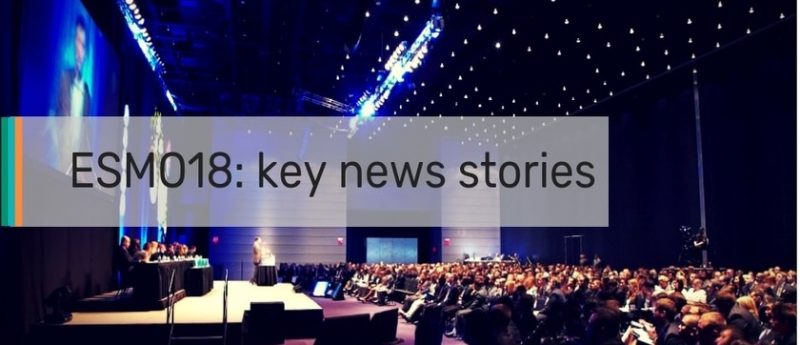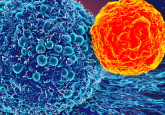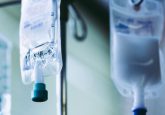ESMO18: key talks and news stories

Find out the key headlines from the ESMO 2018 Congress (19–23 October, Munich, Germany). Keep checking back as we will be adding more news, as it’s released from the conference! Highlights include:
- Financial impact of cancer intensifies disease burden among German patients, study finds
- Breast cancer patients use Twitter as a forum to share their experiences
- Trust in non-conventional therapies by cancer patients not matched with proper awareness about their risks
- Precision oncology is increasingly being utilized in community care settings
- One-sixth of early-stage breast cancer patients could be non-adherent to therapy
- Shorter-course trastuzumab could be an option for HER2+ early breast cancer patients
- Higher instance of certain chemotherapy side effects demonstrated in female oesophagogastric cancer patients
- Olaparib maintenance improves progression-free survival in advanced ovarian cancer by 3 years
- New combination therapy for breast cancer may prolong survival
Financial impact of cancer intensifies disease burden among German patients, study finds
Survey shows that cancer can lead to income loss, associated with adverse psychological effects in addition to material hardship
A systematic literature review of the tools used to measure the subjective financial burden of cancer patients has drawn attention to the fact that the socio-economic burden of cancer is real in Europe, and not only in the context of the US healthcare system where it has been associated with higher morbidity and mortality.
The study, conducted in Germany, highlighted that loss of income is the main source of perceived financial hardship and that this is associated with adverse psychological effects in patients as well as the lack of clear definitions and valid instruments with which to examine this issue.
Eva Winkler, study author from the National Centre for Tumour Diseases (NCT) (Heidelberg, Germany) explained the background of the study: “Of the 39 studies we found, most came from the USA, and the instruments they used were either not transferrable to the German context or not sufficiently focused on the subject.”
“We were, however, able to identify three broad dimensions through which subjective financial burden could be assessed: material aspects, psychological effects and behavioural changes such as support seeking and coping strategies. Based on this, we developed our own, yet non-validated set of questions covering income, cancer-related out-of-pocket costs, distress and lifestyle changes,” study co-author Katja Mehlis from the NCT, added.
A total of 247 patients, 122 diagnosed with neuroendocrine tumours and 125 treated for colorectal cancer, responded to the survey between November 2016 and March 2017. The results of this study brought to light financial impacts in a significant proportion of patients: 80.6% of respondents stated that they faced higher out-of-pocket costs related to their illness.
For over three quarters of the patients who responded to the survey, disease-related out-of-pocket costs amounted to less than 200 euros monthly. Whilst cancer-related income loss was reported by 37.2% of survey participants. “In our study, this effect was more serious than out-of-pocket costs, as the suffered losses exceeded 800 euros per month in almost half of cases. They were mainly due to patients being unable to work or forced to reduce their working hours,” said Mehlis.
The analysis further showed that high financial loss relative to income was significantly associated with a lower estimation of patients’ quality of life and more distress. “The financial impacts that a majority of these patients experienced seem to have contributed to the burden of their disease: the bigger the loss was in proportion to their previous income level, the more negatively they rated their personal situation,” Winkler observed.
“More research is needed to determine what actions are necessary at the system level – for example an extension of the period of eligibility for sickness benefits – or at the individual level, like targeted consulting and support services,” Winkler concluded. “To do this, we will need a valid instrument to measure ‘subjective financial burden’ in the German context, based on a precise definition of the concept.”
Source: www.esmo.org/Press-Office/Press-Releases/financial-toxicity-cancer-Winkler
Breast cancer patients use Twitter as a forum to share their experiences
Analysis of one week’s worth of tweets about breast cancer paints mixed picture of the network’s use by individuals and institutions.
An exploratory study has highlighted Twitter as a platform for many cancer patients to share and discuss their experiences of the disease. The study analyzed the contents of all tweets posted with the hashtag #BreastCancer over a 7-day period.
“Many of the patients we see in daily practice use social media to search for information about their disease, so, as care providers, we wanted to know what kind of content they find there. At the same time, the sheer volume of posts on Twitter represents a rich pool of data we can use to assess attitudes and discourses surrounding cancer,” study author Rodrigo Sánchez-Bayona (Clinica Universidad de Navarra, Pamplona, Spain), commented:
“This study was part of a larger, multidisciplinary project to observe the presence of different diseases on social media. In 2014, we found that cancer was the most mentioned pathology on Twitter globally,” he added.
“When examining the original tweets, we found that only one in three had medical content,” explained Sánchez-Bayona. “However, 90% of this medical information was appropriate, which is likely owed to the fact that 40% of tweets came from institutions and public accounts.”
The categorization of tweets by aim showed that the most frequent motive was patients sharing their experiences, followed closely by patient advocacy. The most common subtheme by far was prevention (44.5% of tweets).
Source: www.esmo.org/Press-Office/Press-Releases/Breast-cancer-twitter-Sanchez-Bayona
Trust in non-conventional therapies by cancer patients not matched with proper awareness about their risks
Complementary and alternative medicines are used by 1 in 2 patients before and during cancer treatments, however they are frequently associated with drug-drug interactions, two studies report.
Findings from a structured survey have demonstrated that sarcoma patients show great openness to the use of complementary alternative medicines (CAMs) for supportive care, but are poorly informed about the safety issues and potential risk of interactions with anti-cancer drugs.
The team from the University Hospital Mannheim (Germany) investigated types and modes of use of non-conventional therapies among 152 outpatients with sarcoma, gastrointestinal stromal tumor (GIST) and desmoid tumors receiving care at a sarcoma center by conducting a 4-month survey.
In this survey CAMS included a broad range of practices including supplementation of vitamins or minerals, homeopathy, Chinese or healing herbs, acupuncture, meditation, yoga, Tai Chi or changes in dietary habits such as switching to a ketogenic or vegan diet.
The results revealed that 51% of participants had used alternative methods in their lifetime and 15% of them only during the disease, in parallel with cancer treatments. Also, cancer diagnosis showed to have sparked patients’ interest in CAMs in 44% of participants.
Despite the reported popularity of non-conventional therapies among patients, clear information on their side effects and potential interactions with other drugs is still lacking. In the survey, 60% of patients recognized that information they had on safety issues of CAMs was insufficient, although they showed low concern for any potential risks.
“Patients tend to believe that supplements or herbs are generally safe, but they are not without risk. In daily practice, if you don’t know what your patient is taking as alternative medicine, the risk of drug-drug interactions can significantly increase and have an impact on clinical outcomes,” Markus Joerger (Cantonal Hospital in St. Gallen, Switzerland) commented.
Precision oncology is increasingly being utilized in community care settings
Nearly 1 in 4 patients with advanced cancer, treated at Comprehensive Cancer Care Network centres in the US, are receiving innovative drugs matched to DNA mutations in their tumors. This achievement shows that cutting-edge precision medicine is spreading from highly specialist cancer units to other healthcare facilities so more patients can benefit, wherever they are treated.
A recent study of patients with advanced cancer being treated at National Comprehensive Cancer Network centers in the USA has explored the degree to which comprehensive genomic profiling (CGP) – led precision oncology are utilized in community care. Ricardo Alvarez (Cancer Treatment Centers of America (CTCA), GA, USA) and colleagues (CTCA and Foundation Medicine, MA, USA) discovered that 23% of these patients received DNA matched treatment, compared with a figure of 11% reported in previous studies.
Of the 6177 patients who underwent CGP, genomic alterations were discovered in 94%, 47% of which were considered to be clinically significant. The most frequent DNA changes of these were in the KRAS (23%) and PIK3CA(15%) genes, and the most common alterations were gene amplifications (32%). Of the 23% treated with DNA matched drugs, 57% received therapies approved for different cancers by the US FDA and 15% enrolled in clinical trials.
“We have shown that we can perform large-scale tumor profiling and use the results to match patients to targeted treatment in the type of community setting where most patients are treated in the United States,” explained Alvarez.
Joaquin Mateo (Prostate Cancer Translational Research Group, Vall d’Hebrón Institute of Oncology, Barcelona, Spain), lead author of a recent paper on the ESMO Scale for Clinical Actionability of molecular Targets (ESCAT) commented: “This is an important study because of the large number of patients and what it tells us about the impact of genomic research on patient care and clinical decisions in the community where the majority of patients are treated. Studies like this are building the evidence we need to implement precision medicine within the oncology community and offer it more widely to our patients.”
Mateo went on to express concern regarding the cost of DNA testing whereby only a quarter of patients stand to gain benefit, while also emphasizing the importance of developing standardized criteria to engender higher levels of confidence and robustness in matching targeted treatments. He indicated that he was hopeful that ESCAT, which grades alterations in tumor DNA in accordance with the clinical evidence supporting their use as markers for targeted treatment, may be adopted to further this purpose.
Looking to the implications of the study, Ricardo Alvarez commented: “In the next few years, we hope that as many as 50% of our patients will receive matched treatment through clinical trials or off-label treatment with approved medicines. It is so encouraging to see how precision medicine is changing the way we treat our patients in the community and our next step is to analyze the effects of targeted treatment on survival and quality of life.”
Sources: Alvarez RH et al. Mutational landscape of metastatic cancers discovered from prospective clinical sequencing at community practice cancer program. Annals Oncol. 29 (Suppl. 8) (2018); www.esmo.org/Press-Office/Press-Releases/Mutations-sequencing-cancer-Alvarez
One-sixth of early-stage breast cancer patients could be non-adherent to therapy
One in six women in therapy for early-stage breast cancer are putting themselves at risk by not adequately adhering to hormonal therapy 1 year into treatment.
One in six premenopausal women being treated for early-stage breast cancer are putting themselves at risk for increased recurrence and mortality by not adequately adhering to tamoxifen therapy just a year into treatment, according to a French study.
The study, presented at ESMO 2018 (19–23 October, Munich, Germany), measured serum levels of a subgroup of 1799 early-stage breast cancer patients in the CANTO study cohort at 1, 3 and 5 years. The researchers then compared measured serum levels with those expected, and with the self-reports of patient adherence.
Lead author Barbara Pistilli, a medical oncologist at Institut Gustave Roussy (Villejuif, France) explained: “This issue is important because non-adherence with hormonal therapy – meaning taking less than 80% of prescribed treatment – can be associated with higher risk of mortality and shorter time to recurrence of breast cancer.”
The study found that 16% (188/1177) of patients were not adequately adherent, and that over one in ten (10.7%) were non-adherent, having no detectable levels of tamoxifen in their serum. At least 50% of the non-adherent patients had not declared that they weren’t taking the tamoxifen.
“I was surprised at the high rate of non-adherence, which was considerably higher than reported previously,” commented Pistilli.
The researchers are planning how to intervene with high-risk patients, and are looking into the social and clinical aspects to non-adherence. This includes patients’ fertility concerns and beliefs or misunderstandings about cancer.
Pistilli concluded: “We need to understand the patients most at risk of being non-adherent early in their treatment and provide targeted interventions aiming to improve their self-efficacy and self-management of side effects.”
Source: www.esmo.org/Press-Office/Press-Releases/nonadherence-endocrine-breast-cancer-CANTO-Pistilli
Shorter-course trastuzumab could be an option for HER2+ early breast cancer patients
Study indicates potential patient groups where a shorter-course of trastuzumab therapy is possible and related savings for the healthcare system
A subgroup analysis of the Short-HER trial has reported that women with HER2-positive early breast cancer with small tumors have similar disease-free survival and lower risk of cardiac toxicity with a 9-week course of adjuvant trastuzumab compared with those treated for 1 year.
Recently reported at ESMO 2018 Congress (19–23 October 2018, Munich, Germany), the trial randomized 1254 HER2-positive early breast cancer patients to either 9 weeks or 1 year’s treatment with trastuzumab, with both groups also receiving chemotherapy.
Results after a median of 6 years’ follow-up showed that the short course did not achieve non-inferiority but was associated with a reduction in the rate of severe cardiac toxicity. The researchers have now analyzed whether there are subgroups of patients where a shorter course of trastuzumab may be non-inferior to a longer course. Multivariate analysis showed that pathologic tumor size and nodal status were independent prognostic factors for disease-free survival.
A second study showed that a 6-month course of adjuvant trastuzumab was cost-effective compared with 12 months, with an average cost saving of nearly £10,000 per patient. This suggests that consideration of shorter-duration trastuzumab may also facilitate access to patients who cannot afford a longer course.
Lead author of the study, Pierfranco Conte (Instituto Oncologico Veneto, Padua, Italy) commented: “The study was underpowered because of difficulties in recruiting patients in a reasonable time so non-inferiority could not be claimed based on the results… Based on our data, 1 year trastuzumab remains the standard treatment for women with HER2-positive early breast cancer.”
Conte added: “Physicians can stop trastuzumab before 1 year in patients who develop a cardiac event during treatment without compromising efficacy and can consider shorter-duration trastuzumab treatment in patients at risk of cardiac toxicity and a low or intermediate risk of breast cancer relapse.”
Commenting for ESMO, Nadia Harbeck (University of Munich) concluded: “The results may impact on clinical decision-making, although it is an exploratory analysis of a negative trial so does not meet the criteria to be practice changing. I think it will influence clinicians and patients in that if patients cannot complete 1 year of trastuzumab, those patients with low tumor burden can feel reassured that they have not lost out on efficacy.”
Higher instance of certain chemotherapy side effects demonstrated in female oesophagogastric cancer patients
A new study on patients with advanced oesophagogastric cancer has revealed statistically significant disparity in both the type and severity of chemotherapy side effects by gender. This could have implications with regards to both support and treatment options.
A team at Royal Marsden Hospital NHS Foundation Trust (London, UK), led by Michael Davidson, have carried out the largest pooled analysis (to date) of gender differences in chemotherapy outcome and toxicity. The research was conducted with advanced oesophagogastric cancer patients treated with equivalent first line chemotherapy. Despite the fact that gender distinctions in treatment reactions have long been observed, previous studies had not been able to glean data regarding specific toxicities in a large cohort.
Although the study, comprising of 1654 individuals (80% male and 20% female), did not demonstrate a significant difference between overall toxicity between genders, it did reveal significant differences between specific side effects. Female patients were observed to suffer a higher incidence and severity of nausea and vomiting (89.3% female versus 78.3% male), with 16.7% of female patients experiencing severity grade 3 or above compared with 9.5% of males.
In female patients increased rates of diarrhea, mouth ulceration and hair loss were observed. However, male patients had a higher instance of peripheral neuropathy. Females were additionally demonstrated to suffer from a higher proportion of gastric cancers, as opposed to junctional or oesophageal cancers.
Although, no significant difference in survival, indicating treatment efficacy, was demonstrated between genders the response rate, indicating the incidence of chemotherapy reducing tumor size, was higher in males to a degree that approached statistical significance.
Davidson explained: “The clinical relevance of this remains to be established. Whilst there is not enough data here to support alternative chemotherapy dosing strategies for men and women, it is useful for clinicians to be aware of such findings in order to refine their treatment in other ways.”
Michel Ducreux (Institut Gustave Roussy; Villejuif, France) commented: “Thanks to the large number of patients included, this analysis was able to show statistically significant gender differences in the frequency of several side-effects of chemotherapy. Now, not only must we discuss their implications, we also need to understand the underlying reasons.”
He added: “Going forward, we might consider stratifying patients according to their gender in clinical trials, so as to evaluate the efficacy and tolerance of treatments in each sex from the beginning of drug development. If further studies systematically confirm that women are more prone than men to a wider range of side-effects, then we will also need to think about entirely different prevention and support strategies for female patients.”
Sources: Davidson M et al. Influence of sex on chemotherapy efficacy and toxicity in oesophagogastric (OG) cancer: A pooled analysis of four randomised trials. Ann. Oncol. 29 (Suppl. 8) (2018); www.esmo.org/Press-Office/Press-Releases/gender-medicine-toxicity-cancer-Davidson




